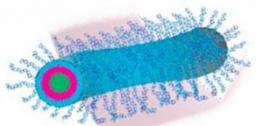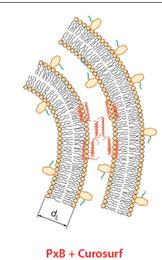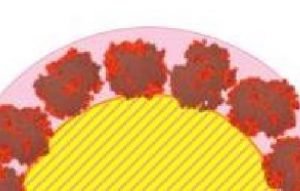Sur la base de travaux pionniers établis dans les années 70 au LLB, la physique des polymères et plus largement l’étude de systèmes relevant de la matière molle (tensio-actifs, nanoparticules) continue d’être un domaine très actif de l’équipe matière molle (MMB) du laboratoire LLB.
Parmi les différents sujets abordés, des efforts spécifiques ont été consacrés à la compréhension de l’origine des propriétés mécaniques remarquables dans des nanocomposites à base de polymère en élaborant des systèmes modèles à base de nanoparticules greffées obtenues par des méthodes de synthèse et/ou fonctionnalisées afin de varier la dispersion des nanoparticules et in fine, les propriétés optiques (résonance plasmon), chirales, catalytiques et de renforcement. Ces nanoparticules peuvent s’auto-organiser en volume dans un liquide ou un fondu de polymère ou un élastomère mais également sous forme de films 2D formés et contrôlés par des liaisons covalentes.
On étudie également la structure, l’organisation et les propriétés mécaniques de milieux poreux formés par séchage contrôlé de solutions de particules en volume ou sur une surface. D’autres domaines de physico-chimie étudiés concernent le comportement des poly électrolytes, soit dans des solutions pures ou complexées avec des objets de charges opposées (protéines, nanoparticules inorganique), et d’étudier l’impact du chemin de formulation de ces systèmes hors équilibre comme voie d’ajustement des propriétés macroscopiques.
Nous étudions également des systèmes multi-composants d’intérêt industriel tels que les mousses alimentaires, des émulsions et fluides pétroliers ou encore de gels de bio-polymères pour les applications en pharmacie dont l’objectif est de relier la structure locale avec les propriétés macroscopiques (viscosité, stabilité…). Une activité importante est développée autour de vésicules à base de copolymères à blocs pour l’encapsulation de principes actifs et le relargage contrôlé et parfois ciblée par l’application d’un stimulus physico-chimique (changement de pH, de température, application d’un champ magnétique pour l’hyperthermie). On s’intéresse spécifiquement à la conformation de polymères en films minces ainsi qu’à la structure de matériaux pour la catalyse.
Pour les applications agro-alimentaires, on étudie la dénaturation des protéines, l’impact de la pression, de la température, des sels, du pH ainsi que des mélanges protéines-polyosides aux interfaces liquide-solide (matériaux nano- ou mésoporeux) liquide-liquide (émulsion)/ liquide-air (mousse).
Une partie de l’activité s’oriente maintenant vers l’étude de polymères ou copolymères conducteurs et semi-cristallins, ainsi que vers la synthèse de matériaux multifonctionnels à base de charges hybrides, poly-phasiques permettant de combiner plusieurs propriétés macroscopiques telles que la stabilité mécanique et la conduction protonique ou la transparence du matériau.
Sur l’ensemble des systèmes abordés par l’équipe matière molle, on bénéficie des possibilités uniques de variation de contraste et de deutération d’un des composants des systèmes de matière molle étudiés mais aussi en diffusion de rayonnement de la complémentarité entre les rayons x et les neutrons pour une gamme de taille caractéristique allant du nm à quelques centaines de nm. Pour certaines études, nous utilisons un nouvel équipement interne de diffusion de rayons x aux petits angles de haute performance, permettant également des mesures par réflectivité et en incidence rasante. Pour des échelles plus grandes (micron), la caractérisation structurale des objets utilise des méthodes complémentaires de microscopie électronique, diffusion de lumière et d’imageries neutronique.












